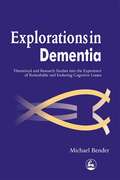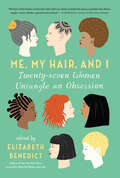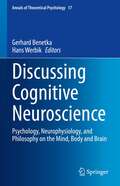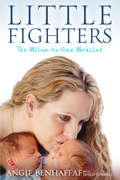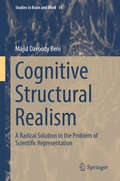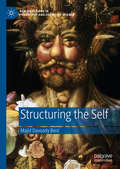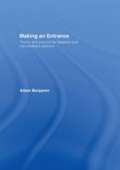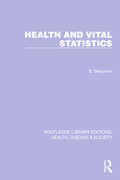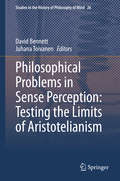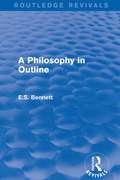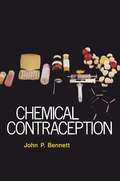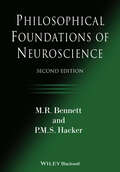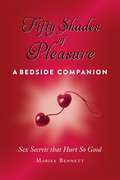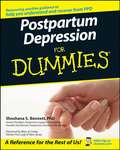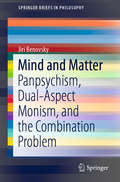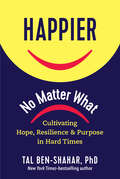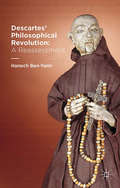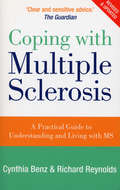- Table View
- List View
Explorations in Dementia: Theoretical and Research Studies into the Experience of Remediable and Enduring Cognitive Losses (PDF)
by Michael BenderBased on the findings of in-depth research and on the author's long-standing experience of working with people with dementia, this ground-breaking book provides fresh perspectives and ideas for policy and practice. In the first part of this extensively referenced and up-to-date book, Michael Bender examines the scientific status of the terms 'dementia', 'Alzheimer's' and 'multi-infarct dementias' and concludes that there is little convincing scientific evidence to justify their continued use. He suggests that in order to develop adequate psychological and social models of dementia, a number of perspectives, such as the intrapsychic, the interpersonal and the contextual, need to be developed. Drawing on contemporary theoretical concepts including multiple selves, personal construct theory, intrapsychic survival and the effect of historical and political factors on older people's well being, the author calls for a more positive and constructive approach to improving the lives of people with dementia. He emphasises the importance of the individual's social context; the problems they are facing and their reactions to those problems; their life history and interpersonal relationships and discusses the process of assessment, finally developing techniques that allow the person with dementia to describe their experience, helping to ameliorate cognitive losses. Taking an honest look at what we really know about dementia and how we can learn more, this innovative book will make essential reading for medical and mental health practitioners, researchers and students working in the field.
Me, My Hair, and I: Twenty-seven Women Untangle an Obsession
by Elizabeth BenedictAsk a woman about her hair, and she just might tell you the story of her life. Ask a whole bunch of women about their hair, and you could get a history of the world. Surprising, insightful, frequently funny, and always forthright, the essays in Me, My Hair, and I are reflections and revelations about every aspect of women&’s lives from family, race, religion, and motherhood to culture, health, politics, and sexuality.
Discussing Cognitive Neuroscience: Psychology, Neurophysiology, and Philosophy on the Mind, Body and Brain (Annals of Theoretical Psychology #17)
by Gerhard Benetka Hans WerbikThe sciences philosophy, psychology and neuroscience share the basis that all refer to the human being. Therefore, an interdisciplinary collaboration would be desirable. The exchange of criticism is an essential requirement for interdisciplinary collaboration. Criticism must be heard and – if possible – considered. Indeed, criticism can be valid or unwarranted. However, whether criticism is unwarranted can only emerge from discussion and conversation. In the discussion of cognitive neuroscience, some criticism can easily be considered (such as the mereological fallacy that represents that talking about the person is substituted with talking bout the brain). Another issue for an interdisciplinary discussion of cognitive neuroscience is the interpretation of the readiness potential including re-considering Benjamin Libet’s classic experiments. Additionally, a critical discussion on cognitive neuroscience must address ethical questions, such as the possibility of the abuse of neuroscientific insight.
Little Fighters: One Year On
by Angie Benhaffaf Edel O'ConnellOn 2 December 2009 two very special baby boys were born in a Great Ormond Street hospital in London. Joined from chest to pelvis, the conjoined twins Hassan and Hussein Benhaffaf’s heart-warming and remarkable fight for life against all odds earned them the title “The Little Fighters”. Written from the heart by their mother Angie, this inspirational book takes you on a miraculous journey from the life-changing moment she discovered her babies were joined to the agony of their separation surgery.From conception to separation and beyond this is a gripping tale of a mother who risked everything so that her boys could have a chance at life. Featuring personal family photos, Little Fighters is a story of courage under fire, hope and unconditional love.This story has struck a chord with every parent who knows that they would stop at nothing to do the best you can for their children. Angie and Azzedine have done this and lots more and captured the hearts of a whole nation in the process. This revised edition carries the story beyond the twins’ second birthday and the fitting of their first prosthetic limbs. Hassan and Hussein, the miracle twins, are walking!
Cognitive Structural Realism: A Radical Solution to the Problem of Scientific Representation (Studies in Brain and Mind #14)
by Majid Davoody BeniIn this book, the author develops a new form of structural realism and deals with the problem of representation. The work combines two distinguished developments of the Semantic View of Theories, namely Structural Realism (SR), a flourishing theory from contemporary philosophy of science, and Ronald Giere and colleagues’ Cognitive Models of Science approach (CMSA).Readers will see how replacing the model-theoretic structures that are at issue in SR with connectionist networks and activations patterns (which are the formal tools of computational neuroscience) helps us to deal with the problem of representation. The author suggests that cognitive structures are not only the precise formal tools for regimenting the structure of scientific theories but also the tools that the biological brain uses to capture the essential features (i.e., structures) of its environment. Therefore, replacing model-theoretic structures with cognitive structures allows us to account for the theories-reality relationship on the basis of the most reliable theories of neurology. This is how a new form of SR, called Cognitive Structural Realism (CSR) is introduced through this book, which articulates and defends CSR, and shows how two diverging branches of SVT can be reconciled.This ground-breaking work will particularly appeal to people who work in the philosophy of science, philosophy of mind and cognitive sciences.
Structuring the Self (New Directions in Philosophy and Cognitive Science)
by Majid Davoody BeniThis book presents a unified account of the self, based on a network of knowledge sourced from several scientific accounts of selfhood. Beni constructs his ontological account of the self from the common structure that underpins the theoretical diversity that is manifested in rival and sometimes incompatible scientific accounts of the self and its aspects. The enterprise is inspired by recent structural realist theories in the philosophy of science, specifying the basic structure of the self, and explaining how representational, phenomenal, and social aspects of the self are embodied within this structure.
The Case for Love: My Adventures In Other Minds
by A K BenjaminAn exhilarating journey into the unfathomable depths of the human mind, from the acclaimed author of Let Me Not Be Mad.What does it take to care for a stranger? Really care.The Case for Love is a reflection on a career treating patients with brain trauma - people whose thoughts and feelings are largely unknowable - and how and why those treatments failed.It is a reconstruction of three haunting cases in which the patients were tragically misunderstood - and an attempt through the power of the imagination to understand and make amends.It then describes the author's abandonment of his career and his tumultuous quest for healing and redemption.It is also a story of intimate relationships, pets, fatherhood and heartbreak, culminating in a moment of psychedelic transcendence and rebirth.It is about the overpowering need for connection - and how, increasingly, we are trapped in ourselves.It is a meditation on empathy and an act of atonement.It is a unique, hybrid work of clinical case study and pure invention that destroys the boundary between fact and fiction in order to bring us face-to-face with the shocking, liberating truth.__________Praise for Let Me Not Be Mad'Imagine a gonzo Oliver Sacks communing with Edward St Aubyn's Patrick Melrose, R.D. Laing and the spirit of Kafka's 'The Country Doctor', and you still won't quite have the flavour of this wild and strikingly original book' William Fiennes'Stunning: clever, troubling, restless, honest, dishonest; one of the best portraits of madness and clinical practice I've read' Olivia Laing'A perfectly extraordinary - not to mention extraordinarily perfect - tense Hitchcockian psychodrama. I have rarely read a more haunting and enthralling account of a descent into madness. An important, profound and fascinating book' Stephen Fry'Blackly comic, warmly compassionate, a unique take on the human mind offering uncomfortable universal truths' Stewart Lee'A slow-burn belter of a book ... terrific ... so finely described, the result has the terse force of a classic short story' Roddy Doyle'Exhilarating ... dazzling ... a miraculous feat' Guardian
Making An Entrance: Theory And Practice For Disabled And Non-disabled Dancers
by Adam Benjamin Christopher BannermanMaking an Entranceis the first ever practical introduction to teaching dance with disabled and non disabled students. This clearly written, thought provoking and hugely enjoyable manual is essential reading whether you're just starting out or are already active in the field. Taking improvisation as his focus and as the starting point of choreographic exploration, Adam Benjamin asks what it has to offer as an art form and how it can be better used to meet the changing needs of dance education. In the theoretical section Benjamin explores the history of a disintegrated dance practice, placing it within the wider context of cultural and political movements. He questions what is meant today when we talk about 'inclusive' or 'integrated dance' and what we might expect of it. The book includes over 50 exercises and improvisations designed to stimulate and challenge students at all levels of dance. Benjamin also includes useful hints on the practicalities of setting up workshops covering issues as diverse a class size, the safety aspects of wheelchairs and the accessibility of dance spaces.
Making An Entrance: Theory And Practice For Disabled And Non-disabled Dancers (PDF)
by Adam Benjamin Christopher BannermanMaking an Entranceis the first ever practical introduction to teaching dance with disabled and non disabled students. This clearly written, thought provoking and hugely enjoyable manual is essential reading whether you're just starting out or are already active in the field. Taking improvisation as his focus and as the starting point of choreographic exploration, Adam Benjamin asks what it has to offer as an art form and how it can be better used to meet the changing needs of dance education. In the theoretical section Benjamin explores the history of a disintegrated dance practice, placing it within the wider context of cultural and political movements. He questions what is meant today when we talk about 'inclusive' or 'integrated dance' and what we might expect of it. The book includes over 50 exercises and improvisations designed to stimulate and challenge students at all levels of dance. Benjamin also includes useful hints on the practicalities of setting up workshops covering issues as diverse a class size, the safety aspects of wheelchairs and the accessibility of dance spaces.
Health and Vital Statistics (Routledge Library Editions: Health, Disease and Society #3)
by Bernard BenjaminOriginally published in 1968, this book was intended to help those in health and welfare services as well as those whose policy decisions are influenced by the movement of statistical indices of health, to understand the purpose, derivation and meaning of these indices. It teaches by presenting statistical problems as they are encountered in practice against the background of day-to-day administrative procedures to which they relate. Special attention is paid to practices in the USA and to considerations of international comparability.
Health and Vital Statistics (Routledge Library Editions: Health, Disease and Society #3)
by Bernard BenjaminOriginally published in 1968, this book was intended to help those in health and welfare services as well as those whose policy decisions are influenced by the movement of statistical indices of health, to understand the purpose, derivation and meaning of these indices. It teaches by presenting statistical problems as they are encountered in practice against the background of day-to-day administrative procedures to which they relate. Special attention is paid to practices in the USA and to considerations of international comparability.
Philosophical Problems in Sense Perception: Testing the Limits of Aristotelianism (Studies in the History of Philosophy of Mind #26)
by David Bennett Juhana ToivanenThis volume focuses on philosophical problems concerning sense perception in the history of philosophy. It consists of thirteen essays that analyse the philosophical tradition originating in Aristotle’s writings. Each essay tackles a particular problem that tests the limits of Aristotle’s theory of perception and develops it in new directions. The problems discussed range from simultaneous perception to causality in perception, from the representational nature of sense-objects to the role of conscious attention, and from the physical/mental divide to perception as quasi-rational judgement. The volume gives an equal footing to Greek, Arabic, and Latin philosophical traditions. It makes a substantial contribution not just to the study of the Aristotelian analysis of sense perception, but to its reception in the commentary tradition and beyond. Thus, the papers address developments in Alexander of Aphrodisias, Themistius, Avicenna, John of Jandun, Nicole Oresme, and Sayf al-Din al-Amidi, among others. The result of this is a coherent collection that attacks a well-defined topic from a wide range of perspectives and across philosophical traditions.
A Philosophy in Outline (Routledge Revivals)
by E.S. BennettFirst published in 1931, this book provides a brief overview of the essentials of philosophy. It aims to combat the notion of the inaccessibility of philosophy by providing an introduction to its history and what the author believes to a ‘minimum dose…of incontrovertible philosophical truth’. The book merely assumes an ordinary level of adult education and offers an outline of the key areas of philosophy — consciousness, reality, experience, Life, God, love, aesthetics, conduct, logic — and as such will be of interest as a very useful starting point for anyone wishing to undertake further studies.
A Philosophy in Outline (Routledge Revivals)
by E.S. BennettFirst published in 1931, this book provides a brief overview of the essentials of philosophy. It aims to combat the notion of the inaccessibility of philosophy by providing an introduction to its history and what the author believes to a ‘minimum dose…of incontrovertible philosophical truth’. The book merely assumes an ordinary level of adult education and offers an outline of the key areas of philosophy — consciousness, reality, experience, Life, God, love, aesthetics, conduct, logic — and as such will be of interest as a very useful starting point for anyone wishing to undertake further studies.
Philosophical Foundations of Neuroscience
by M. R. Bennett P. M. HackerThe second edition of the seminal work in the field—revised, updated, and extended In Philosophical Foundations of Neuroscience, M.R. Bennett and P.M.S. Hacker outline and address the conceptual confusions encountered in various neuroscientific and psychological theories. The result of a collaboration between an esteemed philosopher and a distinguished neuroscientist, this remarkable volume presents an interdisciplinary critique of many of the neuroscientific and psychological foundations of modern cognitive neuroscience. The authors point out conceptual entanglements in a broad range of major neuroscientific and psychological theories—including those of such neuroscientists as Blakemore, Crick, Damasio, Dehaene, Edelman, Gazzaniga, Kandel, Kosslyn, LeDoux, Libet, Penrose, Posner, Raichle and Tononi, as well as psychologists such as Baar, Frith, Glynn, Gregory, William James, Weiskrantz, and biologists such as Dawkins, Humphreys, and Young. Confusions arising from the work of philosophers such as Dennett, Chalmers, Churchland, Nagel and Searle are subjected to detailed criticism. These criticisms are complemented by constructive analyses of the major cognitive, cogitative, emotional and volitional attributes that lie at the heart of cognitive neuroscientific research. Now in its second edition, this groundbreaking work has been exhaustively revised and updated to address current issues and critiques. New discussions offer insight into functional magnetic resonance imaging (fMRI), the notions of information and representation, conflict monitoring and the executive, minimal states of consciousness, integrated information theory and global workspace theory. The authors also reply to criticisms of the fundamental arguments posed in the first edition, defending their conclusions regarding mereological fallacy, the necessity of distinguishing between empirical and conceptual questions, the mind-body problem, and more. Essential as both a comprehensive reference work and as an up-to-date critical review of cognitive neuroscience, this landmark volume: Provides a scientifically and philosophically informed survey of the conceptual problems in a wide variety of neuroscientific theories Offers a clear and accessible presentation of the subject, minimizing the use of complex philosophical and scientific jargon Discusses how the ways the brain relates to the mind affect the intelligibility of neuroscientific research Includes fresh insights on mind-body and mind-brain relations, and on the relation between the notion of person and human being Features more than 100 new pages and a wealth of additional diagrams, charts, and tables Continuing to challenge and educate readers like no other book on the subject, the second edition of Philosophical Foundations of Neuroscience is required reading not only for neuroscientists, psychologists, and philosophers, but also for academics, researchers, and students involved in the study of the mind and consciousness.
Philosophical Foundations of Neuroscience
by M. R. Bennett P. M. HackerThe second edition of the seminal work in the field—revised, updated, and extended In Philosophical Foundations of Neuroscience, M.R. Bennett and P.M.S. Hacker outline and address the conceptual confusions encountered in various neuroscientific and psychological theories. The result of a collaboration between an esteemed philosopher and a distinguished neuroscientist, this remarkable volume presents an interdisciplinary critique of many of the neuroscientific and psychological foundations of modern cognitive neuroscience. The authors point out conceptual entanglements in a broad range of major neuroscientific and psychological theories—including those of such neuroscientists as Blakemore, Crick, Damasio, Dehaene, Edelman, Gazzaniga, Kandel, Kosslyn, LeDoux, Libet, Penrose, Posner, Raichle and Tononi, as well as psychologists such as Baar, Frith, Glynn, Gregory, William James, Weiskrantz, and biologists such as Dawkins, Humphreys, and Young. Confusions arising from the work of philosophers such as Dennett, Chalmers, Churchland, Nagel and Searle are subjected to detailed criticism. These criticisms are complemented by constructive analyses of the major cognitive, cogitative, emotional and volitional attributes that lie at the heart of cognitive neuroscientific research. Now in its second edition, this groundbreaking work has been exhaustively revised and updated to address current issues and critiques. New discussions offer insight into functional magnetic resonance imaging (fMRI), the notions of information and representation, conflict monitoring and the executive, minimal states of consciousness, integrated information theory and global workspace theory. The authors also reply to criticisms of the fundamental arguments posed in the first edition, defending their conclusions regarding mereological fallacy, the necessity of distinguishing between empirical and conceptual questions, the mind-body problem, and more. Essential as both a comprehensive reference work and as an up-to-date critical review of cognitive neuroscience, this landmark volume: Provides a scientifically and philosophically informed survey of the conceptual problems in a wide variety of neuroscientific theories Offers a clear and accessible presentation of the subject, minimizing the use of complex philosophical and scientific jargon Discusses how the ways the brain relates to the mind affect the intelligibility of neuroscientific research Includes fresh insights on mind-body and mind-brain relations, and on the relation between the notion of person and human being Features more than 100 new pages and a wealth of additional diagrams, charts, and tables Continuing to challenge and educate readers like no other book on the subject, the second edition of Philosophical Foundations of Neuroscience is required reading not only for neuroscientists, psychologists, and philosophers, but also for academics, researchers, and students involved in the study of the mind and consciousness.
Fifty Shades of Pleasure: Sex Secrets that Hurt so Good
by Marisa BennettIf the kinky erotic romance novel Fifty Shades of Grey left you breathless with desire, you need the non-fiction companion book Fifty Shades of Pleasure by Marisa Bennett, to help make fiction a reality!Being a vanilla girl curious about BDSM (bondage, discipline, sadism, and masochism) can be intimidating. You're probably conjuring up images of dog collars, dungeon and a leather-clad man who calls himself Master DragonBallz. Fear not, there are ways for a normal girl to try this stuff out with her partner in the comfort of her own bedroom - with no dungeon required. With a light, playful tone, this book explains the basics of 30 light BDSM techniques,à la Fifty Shades of Grey, from spanking and bondage with silk scarves to dirty talk, blind-folding and a little light pinch-and-scratch. Each technique is embellished with an excerpt from the Kama Sutra or classic erotica, for that extra touch of spice.With tips, tricks and fun, easy advice from expert Marisa Bennett, Fifty Shades of Pleasure is the discreet handbook you need to begin your own erotic adventure - perhaps with your very own Christian Grey...Marisa Bennett is a sex writer with a penchant for the erotic. She carried out the research for this book with great energy and enthusiasm, with her husband at their home in Eden Prairie, Minnesota.
Postpartum Depression For Dummies
by Shoshana S. BennettIt's a great blessing when a new mom with postpartum depression (PPD) is fortunate enough to be diagnosed early by a knowledgeable medical practitioner or therapist. But without guidance, it isn't always clear where the boundary between normal baby blues and PPD lies. As with any other illness, the quicker that PPD is identified and treated, the faster the woman will recover. Postpartum Depression For Dummies can help you begin the process of determining what’s going on with you and give you a better idea of where you fall so that you can get yourself into proper treatment right away. The book covers all aspects of PPD, from its history and its origins to its effects on women and their families to the wide variety of treatments available—including conventional Western medicine, psychological therapy, alternative medical treatments, and self-care measures. Postpartum Depression For Dummies reveals: Why some doctors may be hush-hush about PPD How to distinguish between pregnancy hormone changes, "baby blues," and PPD The difficulties of getting a proper diagnosis The role and importance of a therapist The benefits of medication for depression Alternative treatments with a successful track record How to find the right balance of psychological, medical, and alternative treatment Ways you can help foster recovery The nutrition you need to care for yourself properly How to help your partner help you Postpartum Depression For Dummies also provides the additional resources you need—web sites, organizations, and further reading—to help avoid the unnecessary suffering caused by undiagnosed and untreated PPD and survive and thrive as a new mom.
Postpartum Depression For Dummies
by Shoshana S. BennettIt's a great blessing when a new mom with postpartum depression (PPD) is fortunate enough to be diagnosed early by a knowledgeable medical practitioner or therapist. But without guidance, it isn't always clear where the boundary between normal baby blues and PPD lies. As with any other illness, the quicker that PPD is identified and treated, the faster the woman will recover. Postpartum Depression For Dummies can help you begin the process of determining what’s going on with you and give you a better idea of where you fall so that you can get yourself into proper treatment right away. The book covers all aspects of PPD, from its history and its origins to its effects on women and their families to the wide variety of treatments available—including conventional Western medicine, psychological therapy, alternative medical treatments, and self-care measures. Postpartum Depression For Dummies reveals: Why some doctors may be hush-hush about PPD How to distinguish between pregnancy hormone changes, "baby blues," and PPD The difficulties of getting a proper diagnosis The role and importance of a therapist The benefits of medication for depression Alternative treatments with a successful track record How to find the right balance of psychological, medical, and alternative treatment Ways you can help foster recovery The nutrition you need to care for yourself properly How to help your partner help you Postpartum Depression For Dummies also provides the additional resources you need—web sites, organizations, and further reading—to help avoid the unnecessary suffering caused by undiagnosed and untreated PPD and survive and thrive as a new mom.
Mind and Matter: Panpsychism, Dual-aspect Monism, And The Combination Problem (SpringerBriefs in Philosophy)
by Jiri BenovskyIn this book, the author takes a stand for a variant of panpsychism as being the best solution available to the mind-body problem. More exactly, he defends a view that can be labelled 'dual-aspect-pan-proto-psychism'. Panpsychism claims that mentality is ubiquitous to reality, and in combination with dual-aspect monism it claims that anything, from fundamental particles to rocks, trees, and human animals, has two aspects: a physical aspect and a mental aspect. In short, the view is that the nature of reality is 'phental' (physical-mental). But this does not mean, according to the author, that rocks and photons think or have conscious experiences, in the sense in which human animals have experiences. This is where pan-proto-psychism enters the picture as being a better theoretical option, where the mental aspects of fundamental particles, rocks, and trees are not experiential. Many hard questions arise here. In this book, Benovsky focuses on the combination problem: in short, how do tiny mental aspects of fundamental particles combine to yield macro-phenomenal conscious experiences, such as your complex experience when you enjoy a great gastronomic meal? What makes the question even harder is that the combination problem is not just one problem, but rather a family of various combination issues and worries. Benovsky offers a general strategy to deal with these combination problems and focuses on one in particular – namely, the worry concerning the existence of subjects of experience. Indeed, if standard panpsychism were true, we would need an explanation of how tiny micro-subjects combine into a macro-subject like a human person. And if panprotopsychism is true, it has to explain how a subject of experience can arise from proto-micro-mental aspects of reality. Benovsky shows that understanding the nature of subjectivity in terms of the growingly familiar notion of mineness in combination with an eliminativist view of the self, allows us to have a coherent picture, where this type of combination problem is avoided, without throwing the baby out with the bathwater.
Happier, No Matter What: Cultivating Hope, Resilience, and Purpose in Hard Times
by Tal Ben-Shahar PhDNew York Times–bestselling author, psychologist, and happiness expert Tal Ben-Shahar&’s all-new, evidence-based toolbox for finding happiness in hard times
Descartes' Philosophical Revolution: A Reassessment
by H. Ben-YamiBen-Yami shows how the technology of Descartes' time shapes his conception of life, soul and mind–body dualism; how Descartes' analytic geometry helps him develop his revolutionary conception of representation without resemblance; and how these ideas combine to shape his new and influential theory of perception.
Coping With Multiple Sclerosis: A Comprehensive Guide to the Symptoms and Treatments (Positive Health Ser.)
by Cynthia Benz Richard ReynoldsMultiple sclerosis (MS) - a disease of the central nervous system - is the most common disabling neurological condition affecting young adults today. In her authoritative and inspiring book, Cynthia Benz demystifies the illness, explains its symptoms and patterns and offers a wealth of practical advice on coping with MS on a day-to-day basis. Including information on:- How to cope with stress and remain optimistic- Available therapies - from traditional drugs and physiotherapy to alternative treatments including acupuncture, homeopathy and massage- What help is on offer and where it can be foundRevised and updated for the 21st century this is the essential handbook for people with MS, parents and carers alike.
The Arc of Love: How Our Romantic Lives Change over Time
by Aaron Ben-Ze'evIs love best when it is fresh? For many, the answer is a resounding “yes.” The intense experiences that characterize new love are impossible to replicate, leading to wistful reflection and even a repeated pursuit of such ecstatic beginnings. Aaron Ben-Ze’ev takes these experiences seriously, but he’s also here to remind us of the benefits of profound love—an emotion that can only develop with time. In The Arc of Love, he provides an in-depth, philosophical account of the experiences that arise in early, intense love—sexual passion, novelty, change—as well as the benefits of cultivating long-term, profound love—stability, development, calmness. Ben-Ze’ev analyzes the core of emotions many experience in early love and the challenges they encounter, and he offers pointers for weathering these challenges. Deploying the rigorous analysis of a philosopher, but writing clearly and in an often humorous style with an eye to lived experience, he takes on topics like compromise, commitment, polyamory, choosing a partner, online dating, and when to say “I love you.” Ultimately, Ben-Ze’ev assures us, while love is indeed best when fresh, if we tend to it carefully, it can become more delicious and nourishing even as time marches on.
